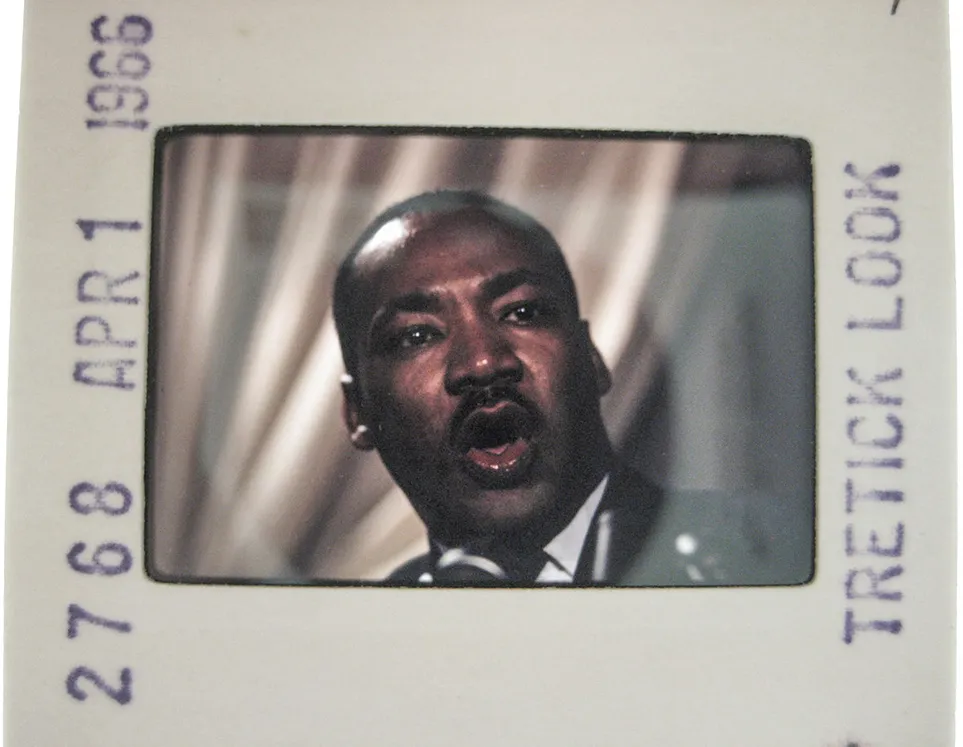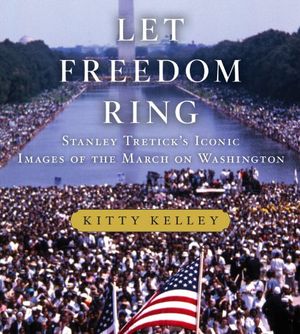In the days and weeks following the March on Washington for Jobs and Freedom, photographs captured by the likes of Danny Lyon and Bob Adelman offered Americans a sense of the sheer scale of the landmark protest. On August 28, 1963, an estimated 250,000 people gathered on the National Mall in Washington, D.C. for a nonviolent demonstration seeking civil and economic rights for Black Americans. Then the largest gathering of its kind, the march was immortalized in images of Martin Luther King Jr. delivering his “I Have a Dream” speech, crowds filling the steps of the Lincoln Memorial and protesters locking hands in a show of unity.
Of the photographic luminaries present at the march, Stanley Tretick is perhaps most intimately associated with the U.S.’s then-president, John F. Kennedy. Two months after the demonstration, Tretick took a now-iconic snapshot of John F. Kennedy Jr. peeking out from his father’s desk in the Oval Office. His photos of the first family defined the public’s vision of Camelot, as the 35th president’s idealized administration came to be called. But Tretick’s images of the March on Washington went unseen for decades, hidden in a Marine Corps footlocker with other mementos from his lengthy career.
/https://tf-cmsv2-smithsonianmag-media.s3.amazonaws.com/filer/c5/13/c5134d22-4cf5-40d8-acdc-6d7376e70a88/march-on-washington-2.jpg)
Before Tretick’s death at age 77 in 1999, he left the locker to one of his close friends, writer Kitty Kelley. When she opened it, she discovered a cache of photos, diaries, letters and other ephemera.
“I didn’t just inherit a trunk,” Kelley told the Herald-Tribune in 2012. “I inherited a whole archive, about 500,000 photographs, slides and negatives. My first reaction was to donate it, but I did a lot of research and I found that while it’s very nice to donate, most of those donations end up in the basements of the Library of Congress or the archives. They’re never really seen.”
Instead of donating Tretick’s images, Kelley published them in two separate books: Capturing Camelot: Stanley Tretick’s Iconic Images of the Kennedys, published in 2012, and Let Freedom Ring: Stanley Tretick’s Iconic Images of the March on Washington, released in 2013 to mark the 50th anniversary of the demonstration. As Kelley explains in Let Freedom Ring, Tretick covered the march for Look, but his work went unpublished “because of the bimonthly magazine’s long lead time.”
Let Freedom Ring: Stanley Tretick's Iconic Images of the March on Washington
A bestselling author and a legendary photographer present an illuminating look at a pivotal moment in our nation's history.
In 2013, Smithsonian magazine exclusively published Tretick’s photos alongside an oral history of the march. Featuring comments from Representative John Lewis, entertainer Harry Belafonte, and activists such as Julian Bond and Delegate Eleanor Holmes Norton, the testimony “remind[ed] us of who we were then as a nation, and where we would move in the struggle to overcome our history,” wrote reporter Michael A. Fletcher.
In honor of the 60th anniversary of the march, Smithsonian is resurfacing Tretick’s snapshots. Below, explore a selection of the photographer’s work, which captures moments like Lewis and A. Philip Randolph, president of the Brotherhood of Sleeping Car Porters and a lead organizer of the demonstration, preparing to give speeches and King, Lewis and other civil rights leaders meeting with Kennedy and Vice President Lyndon B. Johnson shortly after the march.
/https://tf-cmsv2-smithsonianmag-media.s3.amazonaws.com/filer/28/61/28612e49-2f94-4245-aa94-312f5f80a587/march-on-washington-4.jpg)
/https://tf-cmsv2-smithsonianmag-media.s3.amazonaws.com/filer/02/94/02946c2d-ebfc-4b18-8338-c549eb2ceb93/march-on-washington-5.jpg)
/https://tf-cmsv2-smithsonianmag-media.s3.amazonaws.com/filer/26/37/263734db-f6ef-42f6-965e-055b738c1d2a/march-on-washington-7.jpg)
/https://tf-cmsv2-smithsonianmag-media.s3.amazonaws.com/filer/90/92/90923d31-d56d-4834-9d42-57889c577e67/march-on-washington-9.jpg)
/https://tf-cmsv2-smithsonianmag-media.s3.amazonaws.com/filer/16/e2/16e285a9-ac3d-4d3e-9a34-8680501822e4/march-on-washington-1.jpg)
/https://tf-cmsv2-smithsonianmag-media.s3.amazonaws.com/filer/0c/10/0c10e30c-9a54-482d-8372-7c901c23bdda/march-on-washington-10.jpg)
/https://tf-cmsv2-smithsonianmag-media.s3.amazonaws.com/filer/82/96/82962e3b-0dc9-4087-a0e7-5cfddc36c313/march-on-washington-11.jpg)
/https://tf-cmsv2-smithsonianmag-media.s3.amazonaws.com/filer/08/3a/083a77ff-eaaf-4e1a-81d8-68fd0be9fc28/march-on-washington-12.jpg)

/https://tf-cmsv2-smithsonianmag-media.s3.amazonaws.com/filer/JULAUG13_N10_MarchOnWashington-963.jpg)
/https://tf-cmsv2-smithsonianmag-media.s3.amazonaws.com/filer/JULAUG13_N16_MarchOnWashington-963.jpg)
/https://tf-cmsv2-smithsonianmag-media.s3.amazonaws.com/filer/JULAUG13_N17_MarchOnWashington-963.jpg)
/https://tf-cmsv2-smithsonianmag-media.s3.amazonaws.com/filer/JULAUG13_N18_MarchOnWashington-963.jpg)
/https://tf-cmsv2-smithsonianmag-media.s3.amazonaws.com/filer/JULAUG13_N20_MarchOnWashington-963.jpg)
/https://tf-cmsv2-smithsonianmag-media.s3.amazonaws.com/filer/JULAUG13_N21_MarchOnWashington-963.jpg)
A Note to our Readers
Smithsonian magazine participates in affiliate link advertising programs. If you purchase an item through these links, we receive a commission.
:focal(700x527:701x528)/https://tf-cmsv2-smithsonianmag-media.s3.amazonaws.com/filer_public/81/40/81407c7c-6807-4039-a0d0-eb7f3b61dfb6/freedom-rider.jpg)

/https://tf-cmsv2-smithsonianmag-media.s3.amazonaws.com/accounts/headshot/mellon.png)